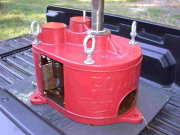|
Practical Use of Invertase to Prevent Sugaring Introduction This essay is intended to provide brief, practical information to a syrup maker who wishes to prevent sugaring in syrup. Although it is not essential, the reader might wish to read my more technical essay on different sugars in cane juice and how they impact syrup attributes. Some of that information is condensed below in order to make this essay self-contained, but the aim here is to present only information that bears directly on prevention of sugaring. This compact format implies, of course, that generalizations made cannot be taken out of this context. Background The predominant sugars in cane juice are sucrose (table sugar), glucose (dextrose, grape sugar), and fructose (fruit sugar). Sucrose is made of one glucose molecule joined to one fructose molecule. Sucrose has the highest tendency to form crystals (sugar) whereas fructose has a very low tendency. Therefore, one means of preventing sugaring in syrup is to break most of the sucrose down into glucose and fructose. In this regard, a practical goal is to keep the sucrose content to less than 40 % of the total sugars. For syrup of identical total sugar content (weight per volume of syrup), less sucrose means the syrup will be slightly less likely to spoil, have a slightly higher boiling point, appear to be thinner, and be a little sweeter. The density (º Baumé) will be unchanged. (I note, as a disclaimer, that crystallization is affected by many parameters that are beyond the scope of this essay.) Sucrose can be broken down readily by enzymes known generically as invertases. An enzyme is a protein that speeds the conversion of one substance to another without being changed itself; therefore, a small amount of enzyme can be very effective because it is used repeatedly. Discovered in 1860, invertase is well known. Indeed, work with invertase led to one of the most fundamental principles of enzymology, the Michaelis-Menten equation (1913), which was quickly put into an effective linear form, the Lineweaver-Burk Plot. Ubiquitous in nature, invertase is usually isolated from bakers yeast for commerce. It is sold at various dilutions; typically, the strength of a preparation is expressed as Sumner Units/gram. In other words, when one purchases a pound of invertase, he or she may get only a fraction of an ounce of actual invertase, which is mixed in a carrier such as modified starch. Invertase is commonly used in the food industry and it was recommended for syrup production in the first part of the 1900s. Then, however, its use required a lot of guesswork since precise formulations were not available. As a typical example, a syrup maker might learn over the years how much of a particular yeast paste is required to prevent sugaring. Now, it is possible to purchase formulations of precise strength at reasonable cost, permitting development of a recipe that can be used readily and effectively by everyone. Effective use of an invertase, or any other enzyme, requires some knowledge of its particular properties. Enzymes are fragile; they must be stored properly and used properly. Instructions of the supplier can usually be followed, but if instructions are not given, commercial bakers yeast invertase should be stored near 40 ºF. This invertase is the most active at pH 5-5.5 and 140 ºF (depending on the solution it is in), and it is unstable above about 120 ºF (particularly at pH below 5). A variety of substances in cane juice and semi-syrup potentially interact with invertase and it is therefore necessary to conduct experiments with cane juice and semi-syrup (and not rely solely on results from a model solution in a laboratory). For several reasons, one wishes to use the minimum effective amount of a commercial enzyme preparation. Several strategies can be used to include use of invertase in syrup processing. First, the historical method is to produce semi-syrup, cool it, and allow incubation with invertase overnight. Then, the semi-syrup is finished the following day. This method is probably geared better for large-scale processing because it is less expensive and permits continual production of semi-syrup. Second, juice can be taken to semi-syrup, cooled, incubated with invertase, and finished then. The major drawback is cooling the semi-syrup and then re-heating it, particularly if one uses a masonry furnace with high heat capacity. Third, the invertase can be added to the juice, allowing incubation before processing. Results from the 2002 Season Using invertase from two different suppliers, we conducted experiments at two field locations using the second and third strategies enumerated above. The amount of invertase was based on theoretical calculations.Conclusions from the 2002 Season Invertase was effective at reducing the sucrose content to acceptable levels when used at the semi-syrup stage (Panel A, Figure 1). A variation of this theme, incubation with juice that had been heated (Panel A, Figure 2) was also effective. As these experiments yielded the desired result, no further optimization is planned. For the small producer, incubation of the juice during collection and settling would be the easiest from an operational standpoint. In a single experiment (Panel B, Figure 2), invertase diminished sucrose, but not sufficiently. Prospects for the 2003 Season A first set of experiments will focus on repeating the experiments conducted with semi-syrup. A second set of experiments will attempt optimization (incubation time or conditions, amount of invertase) for use of invertase with unheated juice. Based on the single experiment (Panel B, Figure 2), it is not possible to determine whether insufficient invertase was used or whether the invertase denatured (via several theoretical possibilities) in the raw juice. Acknowledgements Yun Kang conducted the sugar analyses. Matt Utter (Technical Sales, Bio-Cat) and Edward Kot (Burke Candy Company) are thanked for consultations. Jerry, Linda and Robert Earl Griffin of the Griffin Syrup Mill and Charles Deese of the Deese Syrup Mill are thanked for collaboration |






-t.jpg)
-t.jpg)